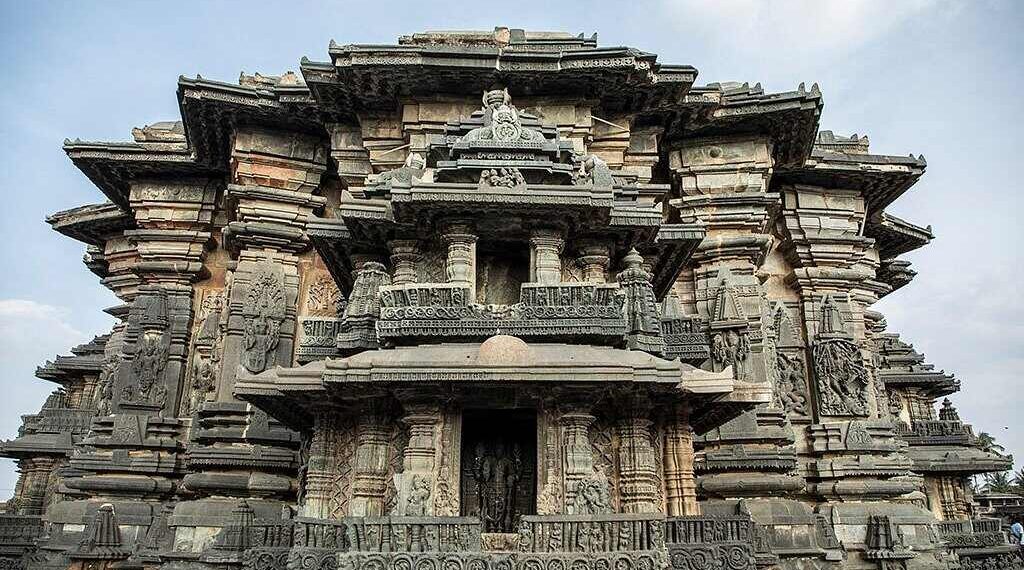The Chennakeshava Temple located in Belur, Karnataka is a holy kshetra for Lord Vishnu, worshipped as Chennakeshava. Constructed in the 12th-century and nestled by the Yagachi River, the temple is a jewel of Hoysala architecture and a UNESCO World Heritage Site. Spanning roughly 3 acres, its detailed carvings, unique star-shaped base, and peaceful courtyards bring in pilgrims from all over India.
Legend of the Temple
The local legends about the Chennakeshava Temple are wide spread. One story says King Vishnuvardhana, a Hoysala ruler, built the temple in 1117 CE to celebrate his win over the Cholas at Talakad. His teacher, Ramanujacharya, told him to dedicate it to Vishnu as Chennakeshava, meaning “Handsome Vishnu.” The temple was a grateful gift to the god dedicating him for his victory. Its carvings in the stone show Vishnu’s stories, like Krishna holding up Govardhana Hill.
Another tale tells of a divine dream. Vishnuvardhana saw Sri Vishnu in his sleep, who asked for a temple in Belur, a special place by the river. The king followed the command, and the temple became a big Vaishnava center, with craftsmen putting their hearts into every stone. People believe praying here brings Lord Vishnu’s help for a good life and safety.
History of Chennakeshava Temple
The temple’s history starts in the 12th century. Old Hoysala writings call it a main Vaishnava shrine, though worship in Belur might go back to older Jain and Shiva sites. The temple we see took 103 years to build, beginning in 1117 CE under Vishnuvardhana. His family, like Narasimha I and Ballala II, kept adding to it. Old records and Vaishnava books show it was a key spiritual spot.
The Hoysala kings, from the 11th to 14th centuries, were its biggest supporters. Stone writings tell of Vishnuvardhana giving gold, land, and cows for priests and prayers. By the 12th century, it was a busy place, with craftsmen, traders, and farmers helping it grow, as village notes say. The Vijayanagara kings, from the 14th to 16th centuries, looked after it, adding a gopuram and halls. The Wodeyars of Mysuru, in the 17th century, fixed carvings worn by time.
In the 1300s, northern Islamic invaders came through, but priests kept the temple’s idols safe like other temples at that time. The Vijayanagara kings brought back its old rituals during their rule. In the 1700s, the Marathas held Belur for a bit, then the British in 1800. The temple stood firm. By 1856, the British took over it, and in 1947, Karnataka’s government looked over it, with the HR&CE Board managing it now.
Architecture of the Temple
The Chennakeshava Temple built over 3 acres is constructed in Hoysala style. The main hall has 48 pillars, each different—some with tiny gods, others fluted. The outer walls have 650 carvings, including 80 madanikas, dancer figures in unique poses, showing Hoysala skill. The Navaranga Mandapa, a pillared hall, shows scenes from the Ramayana and Mahabharata. Its main gopuram, 120 feet high, has carvings of Vishnu’s forms, divine dancers, and animals, sitting on a star-shaped base. The sanctum holds the Chennakeshava murti, a 6-foot black stone Vishnu, carved to perfection. Shantala Devi’s shrine, for Vishnuvardhana’s queen, is close by. A holy tank, the Vishnu Samudra, is in the courtyard. Shrines for Lakshmi, Ganesha, and Garuda are around. Some wall carvings, fixed by the Wodeyars, show Hoysala court life, reflecting the history of the past.
Festivals and Rituals
Festivals make the temple dazzling. The Ratha Yatra, which occurs in March or April, honors Lord Vishnu with a chariot procession through Belur’s streets. Deepavali has extra oil lamps and devotees come here in thousands. The Brahmotsavam, a 10-day festival, brings music and dance. Six daily rituals, from 6 AM to 8 PM, with priests chanting and offering rice and jaggery, keep the temple’s rhythm.
The temple is a big part of Karnataka’s culture. Songs by saints like Purandara Dasa, who sang of Vishnu, shape Vaishnava and Bhakti ways. Festivals bring Carnatic music and Bharatanatyam, keeping Karnataka’s arts going, and the carvings show Hoysala life. The temple’s spot by the Yagachi River, near Halebidu’s temples, ties it to Karnataka’s past as a craft center. Today, it calls people from all over—Belur is 220 km from Bengaluru or 40 km from Hassan, easy by bus or train. Pilgrims often stop at Halebidu’s Hoysaleswara Temple too. Stories like Vishnuvardhana’s vision or the madanikas’ grace live in local songs and family tales.
The Hoysaleswara Temple is an essential part of Karnataka’s culture and history. Old Hoysala writings and saintly songs started here, shaping Saiva beliefs in the region of Karnataka and festivals with music, dance, and marches keep Karnataka’s arts going, and the carvings show life from long ago. These qualities and features of this temple makes Hoysaleswara Temple a must visit for those wanting to travel Karnataka.











